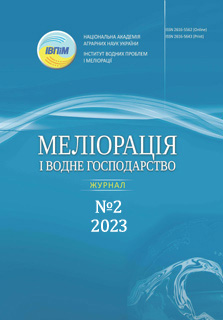IDENTIFICATION OF DESTRUCTION AREAS OF RECLAMATION SYSTEMS AND EVALUATION OF IRRIGATED AGRICULTURE BY THE REMOTE SENSING DATA
Abstract
The article analyzes the results of using the decision-making support system to identify the destruction areas of reclamation systems and evaluates the state of irrigated agriculture by the remote sensing, as well as proves its ability to form and provide the user with preliminary information about the state of reclamation infrastructure. Most of the relatively new and functioning irrigation systems are currently out of the control of the Government of Ukraine due to the occupation of the Kherson and Zaporizhzhia regions by the Russians. Irrigation and drainage systems, over which control was restored and which were in the zone of direct hostilities, were in a destroyed state, and the undermining of the Kakhovska HPP by the occupiers makes it impossible to further use the irrigation systems of both the occupied and unoccupied parts of Ukraine, which were provided with water directly from the Kakhovska reservoir. To provide a rapid visual identification of destruction areas of reclamation systems for evaluating damage to irrigation and drainage infrastructure in 2023, the capabilities of the information system developed at the Institute of Water Problems and Land Reclamation of the National Academy of Agricultural Sciences of Ukraine have been expanded. On the example of the Odesa region, based on basic information about pumping stations of reclamation systems and available information using ACLED technology about hostilities, explosions, artillery attacks, etc., as a result of Russian aggression, a synthesized image was formed, which can be used for visual evaluation of the impact of hostilities on reclamation systems in both individual areas and the whole country. The information system was used for zoning regions by the intensity of military impacts and expected damage to the infrastructure of irrigation and drainage systems. The evaluation of indirect damage zones was carried out using remote sensing data by the NDVI index, which indicates a decrease in the accumulation of biomass in the areas of irrigation systems. The forecast for the further use of irrigated land is based on a statistical analysis of the data on the conclusion of contracts for special water use, which proved a four-fold decrease in water demand, planned for 2022.
The study results can be used to evaluate the damage caused to Ukraine as a result of the war and confirm the devastating impact of the war on the irrigation and drainage sectors.
References
2. Reconstruction For Development: Foreign Experience And Ukrainian Perspectives. (2023). NAS of Ukraine "Institute for Economics and Forecasting of the NAS of Ukraine". http://ief.org.ua/wp-content/uploads/2023/08/Reconstruction-for-development.pdf
3. KSE and Ministry of Agrarian Policy and Food of Ukraine. (2022). Report on damages to infrastructure caused by russia's war against Ukraine one year after the start of the full-scale invasion. https://kse.ua/wp-content/uploads/2023/03/ENG_FINAL_Damages-Report_.pdf
4. Gao, J., & Liu, Y. (2010). Determination of land degradation causes in Tongyu County, Northeast China via land cover change detection. International Journal of Applied Earth Observation and Geoinformation, 12(1), 9-16. https://doi.org/10.1016/j.jag.2009.08.003
5. World Bank; Government of Ukraine; European Union; United Nations. Ukraine Rapid Damage and Needs Assessment: February 2022 - February 2023. (2023). Washington, D.C.: World Bank Group. Retrieved from: http://documents.worldbank.org/curated/en/099184503212
328877/P1801740d1177f03c0ab180057556615497.
6. State Environmental Inspection of Ukraine. (DB). https://www.dei.gov.ua/post/2225
7. Ecodozor. (DB). Ecodozor. https://ecodozor.org/index.php?lang=en
8. EcoZagroza. (DB). https://ecozagroza.gov.ua/en
9. iwpim. (DB). iwpim. http://185.168.130.174:90/
10. Armed Conflict Location & Event Data Project (ACLED). (DB). ACLED. https://acleddata.com/
11. Ragettli, S., Herberz, T., & Siegfried, T. (2018). An unsupervised classification algorithm for multi-temporal irrigated area mapping in central Asia. Remote Sensing, 10(11), 1823.
DOI: https://doi.org/10.3390/rs10111823
12. Romashchenko, M. I., Vozhehova, R. A., & Shatkovskyi, A. P. (2017). Naukovi zasady rozvytku ahrarnoho sektora ekonomiky pivdennoho rehionu Ukrainy [Scientific principles of development of the agrarian sector of the economy of the southern region of Ukraine]. Kherson: OLDI-PLYUS.[in Ukrainian].
13. Irrigation and Drainage Strategy of Ukraine (2017). Washington, D.C.: World Bank Group. http://documents.worldbank.org/curated/en/917821550690263058/Irrigation-and-Drainage-Strategy-of-Ukraine
14. Matiash, T., Kovalchuk, V., Knysh, V., Dyl, K., Polishchuk, V., Saliuk, A., Butenko, Y., & Chorna, K. (2021). Methods and sources of obtaining data for knowledge bases of technical, technological, organizational measures on water and land management planning in reclaimed areas. Land Reclamation and Water Management, (1), 87 - 97.
DOI: https://doi.org/10.31073/mivg202101-278 .
15. Shelestov, A., Drozd, S., Mikava, P., Barabash, I., & Yailymova, H. (2023). War Damage Detection Based on Satellite Data. Proceedings of International Conference on Applied Innovation in IT , Vol. 11, 1, 97-103. 2023, March. Anhalt University of Applied Sciences.
16. Kirui, O. K., Mirzabaev, A., & von Braun, J. (2021). Assessment of land degradation ‘on the ground’and from ‘above’. SN Applied Sciences, 3, 1-13. DOI: https://doi.org/10.1007/s42452-021-04314-z
17. Shammi, S. A., & Meng, Q. (2021). Use time series NDVI and EVI to develop dynamic crop growth metrics for yield modeling. Ecological Indicators, 121, 107124.
DOI: https://doi.org/10.1016/j.ecolind.2020.107124
18. Zhovtonog, O., Polishchuk, V., Filipenko, L., Saliuk, A., Butenko, Y., & Chorna, K. (2020). Study of drought manifestation and its effect on the thermal regime of vegetation surface of crops under irrigation. Land Reclamation and Water Management, (2), 39 - 48.
DOI: https://doi.org/10.31073/mivg202002-263.
19. Ma, Y., Lyu, D., Sun, K., Li, S., Zhu, B., Zhao, R., & Song, K. (2022). Spatiotemporal Analysis and War Impact Assessment of Agricultural Land in Ukraine Using RS and GIS Technology. Land, 11(10), 1810. https://doi:10.3390/land11101810
20. Register of issued permits for special water use – Data sets - Open data portal. (DB). Main page -- Data.gov.ua. Retrieved from: https://data.gov.ua/dataset/water-use-permits


